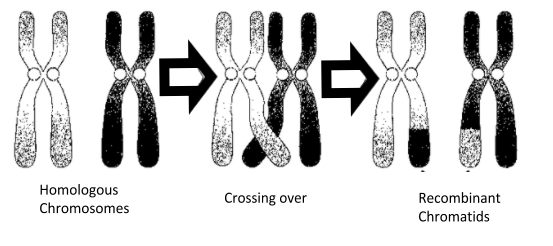
In which stage of meiosis, crossing over takes place?
(a)Pachytene
(b)Leptotene
(c)Metaphase
(d)Anaphase
Answer
578.1k+ views
Hint: In this stage of meiosis formation of recombination nodules is observed. At the end of this phase synaptonemal complex starts dissolving. The name of this stage means ‘thick thread’. Nicking of DNA chromosomes is also seen in this stage.
Complete answer:
During meiosis I in prophase I, crossing over takes place. Prophase I can further be divided into leptotene, zygotene, pachytene, diplotene, and diakinesis.
The pairing of chromosomes is a characteristic feature of meiosis which distinguishes it from Mitosis, Homologous chromosomes pair during the prophase I of meiosis I.
The prophase I stage of meiosis can be elaborated into the following substages- leptotene zygotene pachytene diplotene and diakinesis.

In the leptotene stage chromosomes coil, in the zygotene stage, the chromosomes pair, and a crossing occurs during the pachytene stage between non-sister chromatids of homologous chromosomes.
Crossing over is a process where homologous chromosomes pair up with each other and exchange different segments of genetic material (DNA) to form a Recombinant chromosome.
Diplotene is characterized by the appearance of Chiasma, on the locations at which crossing over has occurred. In diakinesis, the chiasma undergoes terminalisation, and both the homologous chromosomes separate.
So, the correct answer is, “Pachytene.”
Note:
Recombination involves a mutual exchange of the segments of non-sister chromatids between homologous chromosomes. It takes place by breakage and reunion of chromatid segments. Breakage, called nicking, is completed by an enzyme endonuclease and reunion, termed annealing, is assisted by an enzyme ligase
In humans, the meiosis is seen in the haploid gamete cell. Variation occurs due to meiosis, as crossing over and random orientation of homologous pairs is seen in metaphase I.
Complete answer:
During meiosis I in prophase I, crossing over takes place. Prophase I can further be divided into leptotene, zygotene, pachytene, diplotene, and diakinesis.
The pairing of chromosomes is a characteristic feature of meiosis which distinguishes it from Mitosis, Homologous chromosomes pair during the prophase I of meiosis I.
The prophase I stage of meiosis can be elaborated into the following substages- leptotene zygotene pachytene diplotene and diakinesis.

In the leptotene stage chromosomes coil, in the zygotene stage, the chromosomes pair, and a crossing occurs during the pachytene stage between non-sister chromatids of homologous chromosomes.
Crossing over is a process where homologous chromosomes pair up with each other and exchange different segments of genetic material (DNA) to form a Recombinant chromosome.
Diplotene is characterized by the appearance of Chiasma, on the locations at which crossing over has occurred. In diakinesis, the chiasma undergoes terminalisation, and both the homologous chromosomes separate.
So, the correct answer is, “Pachytene.”
Note:
Recombination involves a mutual exchange of the segments of non-sister chromatids between homologous chromosomes. It takes place by breakage and reunion of chromatid segments. Breakage, called nicking, is completed by an enzyme endonuclease and reunion, termed annealing, is assisted by an enzyme ligase
In humans, the meiosis is seen in the haploid gamete cell. Variation occurs due to meiosis, as crossing over and random orientation of homologous pairs is seen in metaphase I.
Recently Updated Pages
Master Class 12 Business Studies: Engaging Questions & Answers for Success

Master Class 12 Economics: Engaging Questions & Answers for Success

Master Class 12 English: Engaging Questions & Answers for Success

Master Class 12 Maths: Engaging Questions & Answers for Success

Master Class 12 Social Science: Engaging Questions & Answers for Success

Master Class 12 Chemistry: Engaging Questions & Answers for Success

Trending doubts
What is meant by exothermic and endothermic reactions class 11 chemistry CBSE

Which animal has three hearts class 11 biology CBSE

10 examples of friction in our daily life

One Metric ton is equal to kg A 10000 B 1000 C 100 class 11 physics CBSE

1 Quintal is equal to a 110 kg b 10 kg c 100kg d 1000 class 11 physics CBSE

Difference Between Prokaryotic Cells and Eukaryotic Cells




